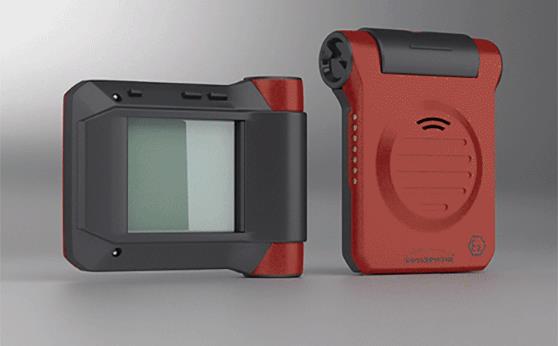Why two channels are better than one
A major UK ambulance service is using two-way paging to supplement the national TETRA radio network, adding a valued extra level of resilience to its radiocommunications
Though the UK operates a national TETRA radio network dedicated to its emergency services and other essential bodies, for one of these services an independent radio network is providing extra resilience.
In Scotland, two-way Responder pagers operating on the UK paging network of PageOne, part of Capita plc, provides a direct link with over 120 senior managers in the National Risk & Resilience team of the Scottish Ambulance Service – a mobile strategic operations team who provide 24/7 management oversight for large, protracted or serious incidents. And the service covers a huge area – not just the Scottish mainland, with its remote and mountainous regions, but the western and northern isles too.
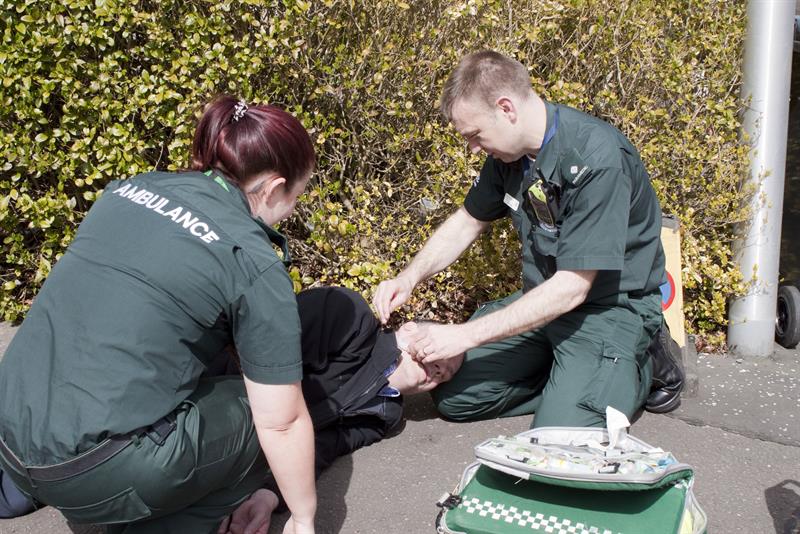
Distribute key information
“The pagers help us to very quickly distribute key information across our management team,” explains Nick Sutton, Strategic Operations Manager for Scottish Ambulance Service. “The Ambulance Control Centres (ACCs) will distribute information via the pagers relating to day-to-day operations as well as specific incident-level information for our more serious and demanding incidents.”
But while most routine communication with ambulance crews is carried via their in-vehicle TETRA radios, Mr Sutton sees it as essential to maintain an independent line of communication with the strategic team, who typically travel to incidents separately in fast-response vehicles and could be away from their vehicle on other duties. “Pagers are sometimes looked upon as an ageing technology that could be replaced by the smartphone and/or digital radios,” he comments. “We feel it is important to maintain a resilient and independent means of communications with our on-call and responding managers that enables the ACC to quickly distribute key information.”
For the Scottish Ambulance Service, PageOne’s two-way Responder paging has helped attain the goal of multi-network resilience. “Any technology that they were already using had its own potential single point of failure,” says Raymond Fegan, of network operator PageOne Communications. Whether the technology is digital radio, mobile phones or one-way paging, he argues, all of them potentially represent a single point of failure. “It’s great when it’s working,” he says. “But when it goes, everything goes. Whereas our two-way pagers here in the UK, we have them operating across multiple networks. So not only are they sitting on our trusted and reliable national paging network, but they are also listening to any of the mobile networks – they’ve always got dual connectivity.”
Critical messages stand out
For Nick Sutton, the Swissphone made paging devices, also help critical messages stand out from the day-to-day smartphone notifications and radio tones. “By having a separate device, it’s less likely to be silenced or powered down as it should only be used for critical events,” he says. But there’s more. “The two-way pagers add an important and, for a very long time, overlooked function to our communications – the ability for the recipient to reply to their message.
“In the near future, we are working with our CAD system supplier to develop a new two-way interface between the CAD and PageOne, which will allow us to leverage the information held in CAD to automatically page incident-level information. Replies from the two-way Responder pagers will also be more easily managed as they will be directed to the dispatcher responsible for the resource.”
Automating response
In this way, the Scottish Ambulance Service hopes to make fuller use of the technology by automating procedures so as to create a consistent and effective message delivery system, relieving pressure on its ACC managers. “Those carrying pagers will be able to send a
specific reply to the message they received and have it handled by CAD, which may result in a message being generated for the dispatcher, or the CAD carrying out some form of action based on the reply. For example, ‘Able to attend’ would generate an allocation request to the dispatcher responsible for the incident.”
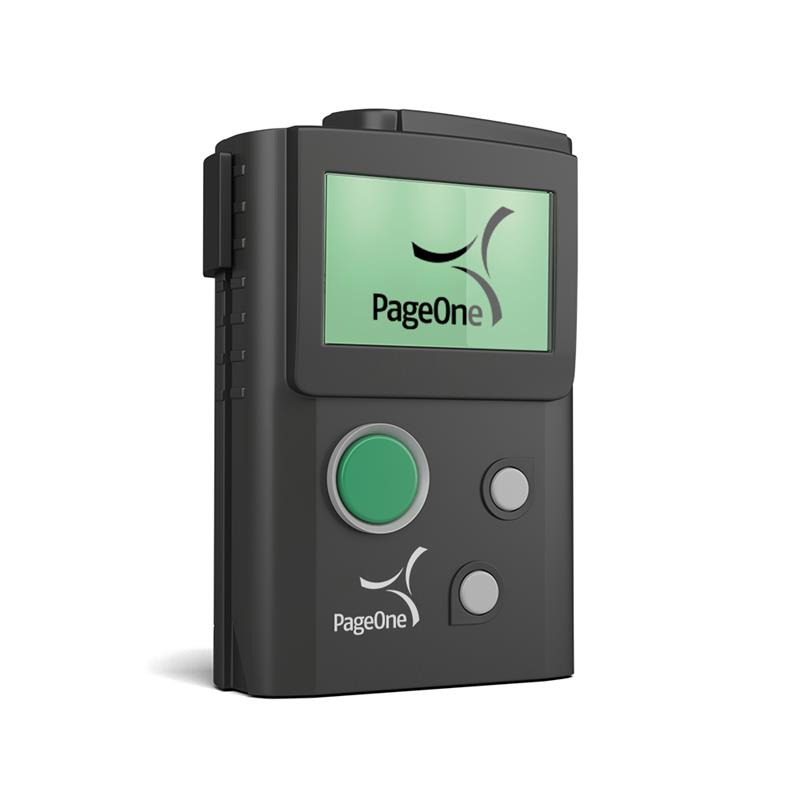
The RES.Q Responder
PageOne uses Swissphone’s advanced two-way pagers. The RES.Q terminals include a GSM wireless module. Options include GPS positioning for locating personnel, an emergency SOS button and Low Energy Bluetooth beacons.
Increasing efficiency
For volunteer firefighters in Germany, a POCSAG paging system provides solid performance at modest cost and is a dependable backup for the national radio network
In Saarland, the smallest of Germany’s federal states, ~13,000 volunteers provide standby fire cover and support for the rescue service through 52 fire brigades.
Alerting is coordinated centrally via ZRF Saar, Saarland’s Integrated Control Centre. “We are responsible for 210,000 operations a year,” said Rainer Buchmann, its director. “Large volunteer fire brigades here in the region have up to 180 operations per year, including up to 50 at night. That makes it all the more important for us to alert volunteers only when they are really required.”
Speed and resiliency
Saarland’s system had to cover virtually 100 per cent of its terrain, including in-building coverage. “And we need fast alerting,” added Mr Buchmann. “In 95 per cent of all cases, the emergency response forces have to arrive on the site of the emergency within 12 minutes after the emergency call was received.”
Saarland chose a resilient POCSAG alerting system from Swissphone with 75 base stations. Its key advantages are coverage, speed and resiliency, including the ability to tolerate a failure of central components. If a master base station can no longer be reached via its normal IP connection, the system ‘connects’ the lost master base stations over the radio network.
Two-way communication
For use on the network, several brigades and rescue services have equipped themselves with Swissphone’s RES.Q pager, which includes a cellular module to provide a return communications path. By pressing a button on the pager, a volunteer can declare that they are ready for action; and then, if an alert arrives, he can notify the control centre whether they will participate. This allows Saarland to alert its first responders in a much more targeted manner and increases the efficiency of their operations.
If the pager cannot detect the POCSAG signal from the dedicated radio network, it automatically connects to the control centre via the cellular network. This ‘hybrid paging’ feature ensures that volunteers can be reliably reached even in Saarland’s border areas.
Given Germany’s national TETRA network, why did Saarland choose POCSAG for alerting? “To obtain the required coverage, we would have had to install far more TETRA base stations due to TETRA’s higher frequency,” says Buchmann. “The POCSAG network provides us with the necessary indoor coverage at only 20 per cent of those costs. Also, TETRA pagers cost up to three times more than POCSAG pagers. we [therefore] use TETRA for voice radio and POCSAG/GSM for alerting.”
Two-way pagers save time
Because first responders can instantly send feedback over RES.Qs, the dispatcher can immediately follow-up with a second and third dispatch if necessary. Saarland’s integrated control centre has reduced the time to alert the required number of volunteers and send them to an incident by up to 15 minutes.
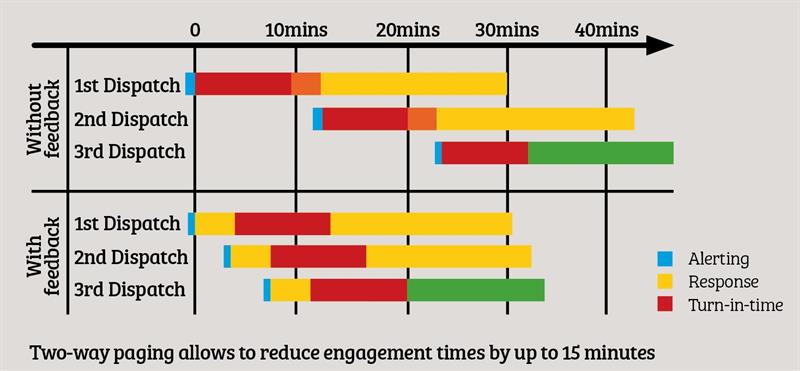
Two-way pagers save money
The Rhineland town of Sankt Augustin’s fire brigade has cuts its annual wage costs by €53,500. This is due to 125 RES.Qs, which reduce over-alerting by allowing volunteers to quickly notify the control centre of their availability. This reduces the compensation that it has to pay employers when they release employees for fire duty. The cost of two-way pagers and SIM cards is deducted (amortisatised over four years) from these annual savings. The acquisition costs are €17,500 per year for 125 devices (€70,000 divided by four). The net benefit is therefore €36,000 per year (€53,500 minus €17,500). The RES.Q pays for itself within six months.
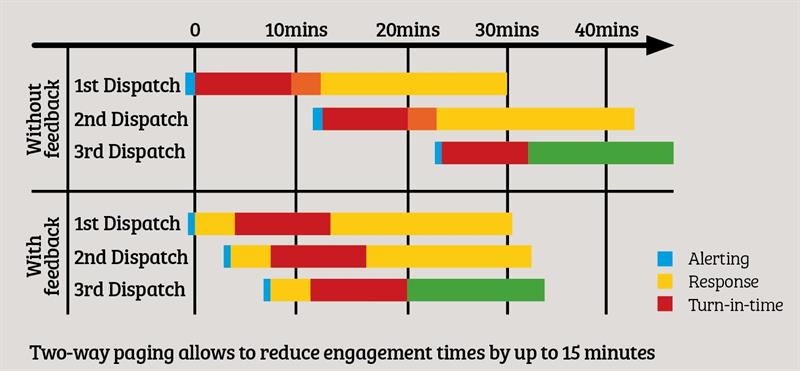
Rescue crews get a boost
In Ireland, the Boyne Fishermen’s Rescue and Recovery Service has seen a significant improvement in its performance after it replaced its old paging system with one from Swissphone
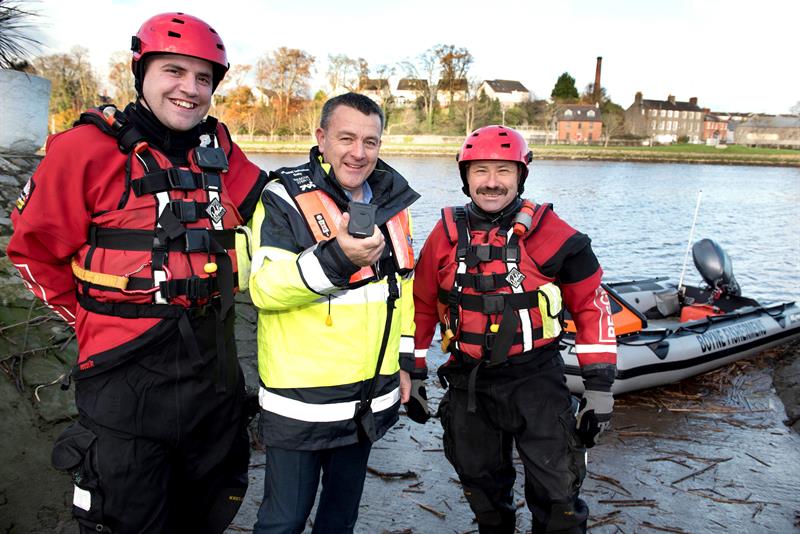
L-R: Jason Clarke, Mark Quinn, and Eugene Brannigan
Established during the 1970s to serve a fishing community centred on the Irish East coast town of Drogheda, the 30 volunteers of the Boyne Fishermen’s Rescue and Recovery Service today rally to incidents not only along the River Boyne and its estuary but on inshore waters for some miles along the coast.
Funded wholly by donations, the service is at the ready around the clock, 365 days a year. It operates a capable fleet of rescue boats and vehicles. And it maintains a specialist diving team, which can perform underwater recoveries anywhere in the 32 counties of Ireland.
Callouts range from the most serious of incidents to cases such as a pleasure boat whose engine has failed or a car stranded in treacherously soft sand after taking a moonlit pleasure drive.
‘Massive improvement’
Recently the service has seen a significant boost in its performance after replacing its old and increasingly unreliable radio paging system with a modern one by Swissphone, which has been trimming minutes off its response times. “There is a massive improvement,” says Jason Clarke, who manages the system. In the past, he explains, patchy radio coverage meant that each callout had to be transmitted several times to ensure that everyone received it. “Definitely there’s minutes saved by only having to set them off once,” says Clarke.
One particular weak spot was not far from the boathouse, in a part of the town where several of the responders live. “They could be sitting at home and they weren’t getting the pages with the old system,” says Clarke. “The new system gets to them, and that means the boat is now getting out much quicker on to the water.”
Like the old system, the new equipment provides voice paging, delivering a brief spoken message to each pager the recipient can replay as required. Much of the improvement in performance with the new system is due to a change from UHF to VHF radio, which gives a longer reach. In addition, the Swissphone equipment offers selective calling to reach specific groups or individuals. Also, since the service has no central control room, it helps that the system can be operated from any telephone.
Simple to use
To send a call, Clarke simply dials into the system – usually from his mobile phone – and enters first a security code (a precaution against false alerts). Then he keys the number of the individual or task group he wants to contact. “I have a list of all the pagers,” he says. “So I could type in 101 and then I would wait about six seconds and then I can talk. If I want the whole team, I can type in 999.”
“It’s simple to use and robust; it’s why we recommended the Swissphone solution to the customer,” adds Mark Quinn, managing director of EMR Integrated Solutions, the radio communications company that supplied the system. “Rescuers must have complete confidence in the system as they need high-performance communications to the emergency services and their colleagues that won’t let them down.”
Future-proof
But the Swissphone s.QUAD Voice pagers used by the Boyne crews have capabilities that go well beyond their present needs. For example, they can also receive digital pages and display text messages. Also, they can use Bluetooth for linking to a smartphone which serves as a gateway to communicate the user’s availability before an alert and to reply to a message. “What they wanted to start off with was just to replace the system that they had,” explains Quinn. “If they want any additional functionality down the road, then we can give that to them – on demand.”
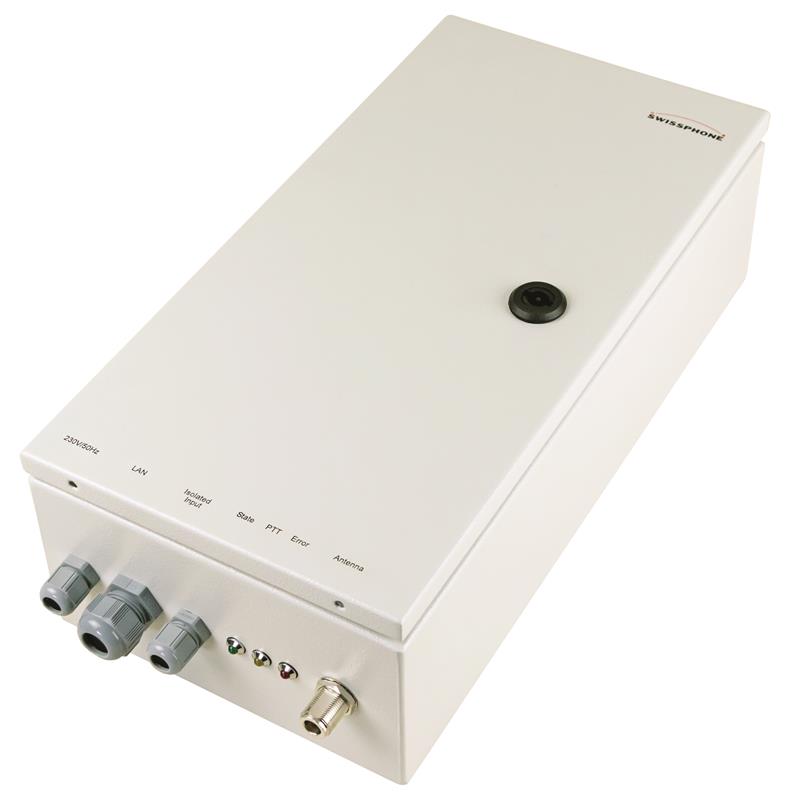 New Voice POCSAG solution
New Voice POCSAG solution
Swissphone’s new onsite voice POCSAG transmitter allows the dispatch of voice and text messages at the same time – for applications that require both types of messages, such as in industry or healthcare, or for migrating to digital while keeping old analogue pagers in operation.
Fully integrated security
In Abu Dhabi, Swissphone’s I.SEARCH alerting system is being used to enhance security for a major oil and gas project through integration with the site’s security systems
Centred on two newly constructed artificial islands in the Arabian Gulf, some 120 km from Abu Dhabi City, the Satah al Razboot (SARB) project of the Abu Dhabi Marine Operating Company (ADMA-OPCO) supports the drilling of 86 oilwells. The installation’s wireless alerting system is being supplied by 3W Networks – a Dubai-based systems integrator.
Paging as a requirement
“For us this is a US$15mn project,” comments Walid Gamali, CEO of 3W Networks. “The oil and gas project has many telecommunications and security systems. Most oilfields require a paging system as a redundant alarming solution which can deliver the message dependably in even the most difficult radio conditions. Swissphone was the partner of choice for this key part of the safety system.”
Fully integrated backup system
For a large part of its everyday mobile communication needs across the site, the oilfield operator will be able to use a local TETRA-based digital two-way mobile radio system.
“Two-way radio is very easy to use, but paging is required for two reasons”, Gamali continues. “First, it is required as a fallback option if the two-way radio system fails, second our client needs a system owned by him for fully integrated alarming options. The TETRA system is provided by Abu Dhabi police – and so ADMA will not have the full features like interfacing third-party systems or having their own dispatching systems. Swissphone’s paging solution is interfaced to the site’s other systems like fire and gas systems through an alarm server also provided by Swissphone.”
Escalation management
3W’s engineers have installed Swissphone paging systems on each of the three islands, each one providing full indoor coverage. Management and message dispatching terminals are provided at each site, and the sites are interconnected over a shared business LAN. The installation is based on Swissphone’s modular I.SEARCH alarm server (shown below).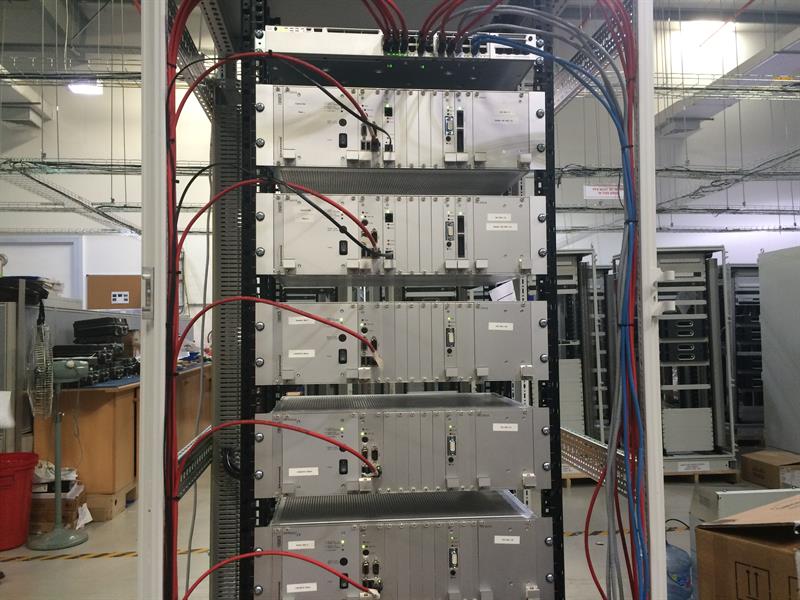
It maintains a database of pagers, messages and settings, and supports a comprehensive range of messaging and alerting services, with automatic logging of calls and transmitter state. Predefined messages can be directed automatically to individuals or groups by telephone, web input or email, with instructions on how to respond.
An escalation management function enables unanswered alerts to be handled according a prepared plan. And there is an absence feature for the pagers themselves: Swissphone’s multi-slot recharging stations can be monitored remotely by the administrator over the LAN, to find whether an individual pager is available for use or is out on duty.
“We can operate the system via a web browser,” says Gamali, “so there is no need for special software or a special licence to run the system.”
High availability cluster
Another element of importance in this messaging application is Swissphone’s High Availability Cluster module, which combines two I.SEARCH racks into a cluster. “Our client likes the clustering mode,” comments Gamali. “Instead of having an auto changeover unit for the main and standby, the clustering mode makes the main and standby understand each other and they are monitoring each other without any additional box for auto-changeover.”
The whole cluster can be addressed via a single virtual IP address. One further benefit in a multi-site paging network such as the SARB installation is that the Swissphone system is fully asynchronous. “Having an asynchronous system helps us to have outdoor coverage and indoor coverage without having a GPS clock attached to every transmitter,” Gamali concludes.
New s.QUAD ATEX
Swissphone’s new s.QUAD ATEX pager can be used even in the most sensitive zones without risk thanks to its protective measures (protection class II 2G EEx ib IIC T4). It is IP67 rated, has an outstanding reception performance and battery lifetime, as well as a very high alerting volume.
The s.QUAD ATEX is available for digital POCSAG networks or analogue radio networks for voice paging, or it can work in both modes in parallel as a single device.
Together with Swissphone’s new Voice POCSAG system, this option supports applications that require both voice and text messages, or migration to digital while keeping old analogue pagers in use.
